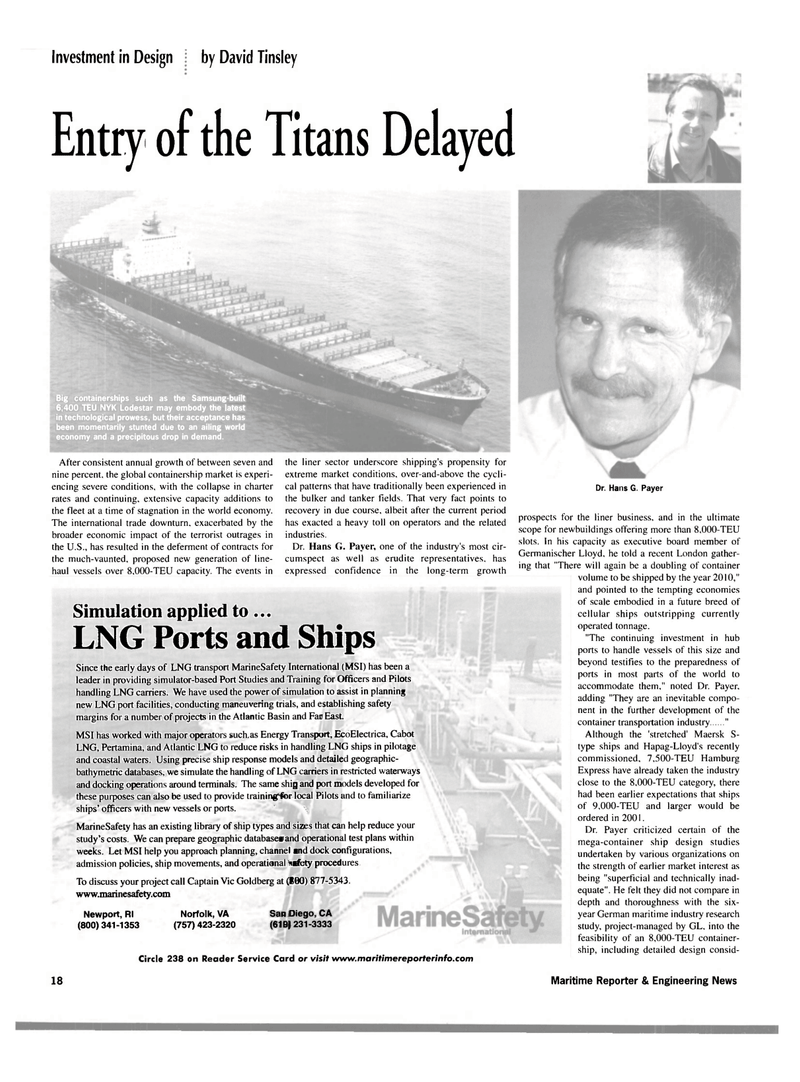
Page 21: of Maritime Reporter Magazine (January 2002)
Read this page in Pdf, Flash or Html5 edition of January 2002 Maritime Reporter Magazine
Investment in Design ; by David Tinsley
Entry of the Titans Delayed
After consistent annual growth of between seven and nine percent, the global containership market is experi- encing severe conditions, with the collapse in charter rates and continuing, extensive capacity additions to the fleet at a time of stagnation in the world economy.
The international trade downturn, exacerbated by the broader economic impact of the terrorist outrages in the U.S., has resulted in the deferment of contracts for the much-vaunted, proposed new generation of line- haul vessels over 8,000-TEU capacity. The events in the liner sector underscore shipping's propensity for extreme market conditions, over-and-above the cycli- cal patterns that have traditionally been experienced in the bulker and tanker fields. That very fact points to recovery in due course, albeit after the current period has exacted a heavy toll on operators and the related industries.
Dr. Hans G. Payer, one of the industry's most cir- cumspect as well as erudite representatives, has expressed confidence in the long-term growth
Simulation applied to...
LNG Ports and Ships
Since the early days of LNG transport MarineSafety International (MSI) has been a leader in providing simulator-based Port Studies and Training for Officers and Pilots handling LNG carriers. We have used the power of simulation to assist in planning new LNG port facilities, conducting maneuvering trials, and establishing safety margins for a number of projects in the Atlantic Basin and Far East.
MSI has worked with major operators such as Energy Transport, EcoElectrica, Cabot
LNG, Pertamina, and Atlantic LNG to reduce risks in handling LNG ships in pilotage and coastal waters. Using precise ship response models and detailed geographic- bathymetric databases, we simulate the handling of LNG carriers in restricted waterways and docking operations around terminals. The same ship and port models developed for these purposes can also be used to provide training for local Pilots and to familiarize ships' officers with new vessels or ports. I? i -
MarineSafety has an existing library of ship types and sizes that can help reduce your study's costs. We can prepare geographic databases and operational test plans within weeks. Let MSI help you approach planning, channel and dock configurations, admission policies, ship movements, and operational safety procedures
To discuss your project call Captain Vic Goldberg at (800) 877-5343. www.marinesafety.com
Newport, Rl (800) 341-1353
Norfolk, VA (757) 423-2320
San Diego, CA (619) 231-3333
Circle 238 on Reader Service Card or visit www.maritimereporterinfo.com
Dr. Hans G. Payer prospects for the liner business, and in the ultimate scope for newbuildings offering more than 8,000-TEU slots. In his capacity as executive board member of
Germanischer Lloyd, he told a recent London gather- ing that "There will again be a doubling of container volume to be shipped by the year 2010," and pointed to the tempting economies of scale embodied in a future breed of cellular ships outstripping currently operated tonnage. "The continuing investment in hub ports to handle vessels of this size and beyond testifies to the preparedness of ports in most parts of the world to accommodate them," noted Dr. Payer, adding "They are an inevitable compo- nent in the further development of the container transportation industry "
Although the 'stretched' Maersk S- type ships and Hapag-Lloyd's recently commissioned, 7,500-TEU Hamburg
Express have already taken the industry close to the 8,000-TEU category, there had been earlier expectations that ships of 9,000-TEU and larger would be ordered in 2001.
Dr. Payer criticized certain of the mega-container ship design studies undertaken by various organizations on the strength of earlier market interest as being "superficial and technically inad- equate". He felt they did not compare in depth and thoroughness with the six- year German maritime industry research study, project-managed by GL, into the feasibility of an 8,000-TEU container- ship, including detailed design consid- 18 Maritime Reporter & Engineering News
Big containerships such as the Samsung-built 6,400 TEU NYK Lodestar may embody the latest in technological prowess, but their acceptance has been momentarily stunted due to an ailing world economy and a precipitous drop in demand.

 20
20

 22
22
